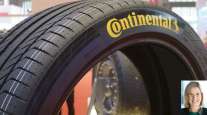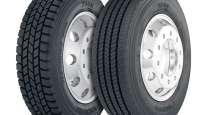Improved Retreads Help Wide-Base Tire Users Extend Life of Product, Say Fleets, Makers
This story appears in the Feb. 3 print edition of Transport Topics.
Wide-base tires, new and retreaded, are providing an extended-mileage benefit for dry-van carrier Bear Trucking Inc., according to a company manager.
“The mileage is excellent,” said Wayne Jacobi, operations manager for the San Bernardino, Calif.-based company. The fleet runs three brands of wide tires on about 45 tractors and 140 trailers, he added.
Singling out a recent example in which new wide-base tires on a tractor operated exclusively by one driver lasted more than 200,000 miles, Jacobi said, “When we finally pulled them off, they were still ‘capable’ casings.”
After being recapped, those tires have been running on a trailer and are expected to reach the same mileage. “We have been doing recaps on the wide-base tires since 2010,” he said.
Bear typically would get between 150,000 and 160,000 miles on drive tires in a dual configuration, Jacobi said, before retreading was needed. Quality retreads have been a staple for the trucking industry. Many retreaders, though, use outdated equipment to remove the original tread from wide tires — a process called buffing — said Scott Miller, ContiLifeCycle manager for Continental Commercial Vehicle Tires in Fort Mill, S.C. Retreaders have been steadily replacing their machines with newer, computerized buffers that can be used on all truck tires, he said.
“This makes the buffing step more precise, in order to remove the appropriate amount of original tread and yet keep a safe distance from the belt package,” Miller said.
David Stevens, managing director of the Tire Retread and Information Bureau in Falls Church, Va., said,“Continued adoption of wide-base tires by fleets that do careful [return-on-investment] analysis and have tire-maintenance programs shows that for the right application, wide-base tires can provide economic benefits — including successful multiple retreads.”
He added: “There really haven’t been changes in the retreading process for wide-base tires,” which he said has been in existence for more than 20 years.
What has changed, Stevens said, is that tire sizes that were predominately used on refuse trucks and saw “very little, if any, use in linehaul trucking” have evolved, and the retread industry “has adapted to take on the challenge of retreading these tires for line-haul use.”
For retreaders, Stevens said, “That means having the right equipment, having personnel trained properly and working with their customers to set acceptable repairable limits and inspection standards for these wide-base tires.”
As with dual tires, casing is critical to retreading, tire manufacturers said.
Rick Phillips, senior director of sales, commercial and OTR products for Yokohama Tire Corp. in Fullerton, Calif., said, “Retreadability begins and ends with the quality of the casing. It doesn’t really matter which retread process is used if the casing is not built to stand up to another life cycle.”
And Paul Crehan, director of product marketing for Michelin Truck Tires in Greenville, S.C., said “high-quality” casings are “fully retreadable several times.”
“Compounds, siping, tread design, inspection equipment and processes are all areas where great strides [also] have been made,” he added.
Last year, Michelin launched a wide-base retread for the linehaul drive position. And Continental Tire has introduced a retread for its HTL1 wide-single retread.
Additionally, the Goodyear Tire & Rubber Co., based in Akron, Ohio, has wide-base tires with “DuraSeal,” — a feature that “instantly seals punctures of up to a quarter-inch in diameter in the repairable area of a truck tire’s tread,” said Brian Buckham, commercial brand manager, adding that the feature “helps ensure casing integrity” for retreads by not allowing the tire to go flat.
“If the tire continues to roll while losing air, its casing durability will begin to degrade over time — similar to running a tire at a low air pressure,” Buckham said.
However, not all tire makers agree about multiple retreads of wide-base tires.
Tread-wear performance on wide tires is improving but has room for improvement.
“It’s still not anywhere near as good as standard tire performance,” said Walt Weller, vice president of CMA, which is based in Monrovia, Calif., and makes Double Coin tires. “At this stage in the development of the product, you’re doing really good if you can get one retread out of these tires.”
In contrast, a standard tire can be retreaded twice and in many cases three times, Weller said.
Sandridge Food Corp. in Medina, Ohio, uses wide-base tires but skips the retreading option.
Jeff Emmons, manager of transportation and fleet maintenance at SFC — which has 24 tractors and 32 refrigerated trailers — said that while retreading has gotten better, he prefers returning the used tires for credit toward the purchase of new wide-base tires, calling his approach “insurance.”
“Downtime for me is just really, really, really bad. So I have to [ensure] that I eliminate any tire problems as much as I can,” he said.
He added, “I can work with vendors on better pricing rather than be at the mercy of a roadside service. The nice thing is, I’m getting a value out of the casing when I’m done with it. That’s worth a value. I’m selling it to my tire vendor, and he’s giving me credit for that, which I use toward my new purchase.”
Emmons said that though he intends to continue his current policy, he was not ruling out recapping.
Although retreadability plays an important role in the purchase of wide-base tires, the products offer other benefits that are driving a perceived sales growth — such as weight and fuel savings, tire makers and fleets said.
CMA’s Weller said Double Coin is a relative newcomer to the wide-tire market. He also said the price for a wide tire can range from $575 to $1,000.
“Our sense is that [sales are] growing, slowly,” Weller said. He described the wide-tire market as a niche that can be profitable for manufacturers targeting weight-sensitive carriers.
For such fleets, the product makes sense. “There is no disputing that these tires save fuel as well,” Weller said.
Continental Commercial Vehicle Tires also is a relatively new entrant to the market for wide single-truck tires in the longhaul application.
“For us, sales in this particular segment have been increasing as awareness grows,” said Alex Chmiel, director of marketing. “It’s not a difficult decision for [certain] fleets, especially liquid bulk haulers, to translate the additional carrying capacity of several hundred pounds payload into terms of the additional profit they’ll gain.”
He added, “But for other fleets [that] may be looking at the products to optimize both fuel efficiency and mileage, there are still many duals on the market that are capable of outperforming super singles.
“This, coupled with the acquisition cost for tires, wheels and rim assemblies, can be challenging for some fleets if they already have a successful fuel-savings program.”
Sales volume of Bridgestone Commercial Solutions’ ultra-wide-base tires has been steadily increasing over the past few years, said Matt Frank of Bridgestone product marketing. He attributed the growth to improved product performance, greater market acceptance and a broader selection of product.
Yokohama introduced a wide-drive tire and a wide-trailer tire about two years ago, and sales have increased steadily, Phillips said. The tire maker plans to introduce two more wide-drive tires early this year, and a new fuel-efficient tire is on the drawing board, he said.
Phillips said that tanker fleets and bulk haulers see an immediate increase in payload capacity due to the weight savings from wide-base tires.
“There is a fuel-savings advantage as well,” he added, “but that can be a bit more difficult to accurately track and document unless the fleet keeps very good records.”
Michelin’s Crehan said a growing number of fleets and owner-operators are recognizing the fuel-saving and operational benefits. For example, a Michelin wide-base tire can save “up to 10% in fuel and almost 200 pounds per axle,” he added.
But a problem with wide-base tires and their wheels involves the possibility of a blowout on a truck traveling at highway speed.
“If you’re doing 65 or 70 miles an hour down the road and one of these tires goes down, by the time you realize it and are able to pull over,” the tire and the rim are destroyed in many cases, CMA’s Weller said.
“If you have a blowout, you’re guaranteed you’re going to lose a rim,” Bear Trucking’s Jacobi said. “The weight just drops down on the rim, and the rim’s gone.”
He also said such events were infrequent: “We just don’t have very many road calls on them.”
Sandridge’s Emmons said the rate of such occurrences — losing tire and rim — was very low in the six years the fleet has been running wide wheels and tires. The fleet consists of 24 tractors and 32 refrigerated trailers, running on two brands of tires.
“I’ve had two situations out of maybe 30 tire issues on the road [where] we ended up needing a rim,” he said.
Three years ago, the Sandridge fleet began installing a tire-pressure monitoring system. Today, the system is on all tractors and trailers in the private fleet, Emmons said.
“If one of my guys is driving down the road, and they have a tire losing air, that’s going to notify them,” he said.
Overall, the switch to wide-base wheels has been good for Sandridge. “We’re saving over a thousand pounds per combination. That’s allowed us to put more product on our trailers,” Emmons said.
Jacobi estimated Bear Trucking’s weight savings is about 150 pounds per wheel position, adding up to 600 pounds per trailer. The savings allowed that much more of customers’ products to be loaded, he said.




